- Table of Contents
- Related Documents
-
| Title | Size | Download |
|---|---|---|
| 01-Text | 1.21 MB |
Contents
General safety recommendations
Examining the installation site
Installing the wireless switch
Mounting the wireless switch on a workbench
Installing the wireless switch in a 19-inch rack
Grounding the wireless switch with the grounding terminal on the chassis (recommended)
Grounding the wireless switch with a grounding conductor buried in the earth ground
Grounding the wireless switch by using the AC power cord
Installing a lightning protector for a network port (optional)
Connecting a copper Ethernet port
Logging in to the wireless switch
Logging in through the console port
Setting up the configuration environment
Powering on the wireless switch
Powering on the wireless switch
Logging in through the web interface
Hardware management and maintenance·
Logging in to the switching engine by using OAP
Displaying hardware information about the wireless switch
Displaying software and hardware version information about the access controller engine
Displaying operational statistics for the wireless switch
Displaying detailed information about the wireless switch
Displaying the electronic label data for the wireless switch
Displaying the CPU usage of the wireless switch
Displaying the memory usage of the wireless switch
Displaying the operational status of the built-in fans
Displaying the operating state of a power module
Configuring the exception handling method
Displaying the exception handling method
Configuration terminal problems
Technical specifications
Table 1 Technical specifications
|
Item |
Specification |
|
|
Dimensions (H × W × D) |
43.6 × 440 × 270 mm (1.72 × 17.32 × 10.63 in) |
|
|
Weight |
4.0 kg (8.82 lb) |
|
|
Rate voltage range |
100 VAC to 240 VAC, 50 Hz or 60 Hz |
|
|
Maximum voltage range |
90 VAC to 264 VAC, 47 Hz to 63 Hz |
|
|
System power consumption |
28 W to 38 W |
|
|
Fans |
· 1 for the motherboard · 2 for the power modules |
|
|
CF card |
1 GB |
|
|
Fixed ports |
Console port |
One port, 9600 bps (default) to 115200 bps |
|
Ethernet port |
Eight 10/100/1000 Base-T autosensing Ethernet ports |
|
|
SFP port |
Two 1000Base-X SFP ports |
|
|
USB port |
Two USB 2.0 ports |
|
|
Flash |
Access controll engine |
16 MB |
|
Switching engine |
16 MB |
|
|
Memory |
Access controll engine |
512 MB DDR2 |
|
Switching engine |
128 MB DDR2 |
|
Front panel
The H3C WX3010E wireless switch provides eight 10/100/1000Base-T autosensing Ethernet ports, two 1000Base-X SFP ports, two USB ports, and one console port on the front panel.
Figure 1 Front view

|
(1) 10/100/1000Base-T autosensing Ethernet port LEDs |
|
|
(2) 1000Base-X SFP port LEDs |
(3) System status LED (PWR) |
|
(4) PoE/PoE+ status LED |
(5) Console port |
|
(6) USB port |
(7) 1000Base-X SFP ports |
|
(8) 10/100/1000Base-T autosensing Ethernet ports |
|
Rear panel
The wireless switch provides AC receptacles on the rear panel.
Figure 2 Rear view

|
(1) AC receptacle |
(2) Retention tab to secure the power cord |
|
(3) Grounding screw |
|
Safety recommendations
Safety symbols
When reading this document, note the following symbols:
![]() WARNING means an alert that calls attention to important information that if
not understood or followed can result in personal injury.
WARNING means an alert that calls attention to important information that if
not understood or followed can result in personal injury.
![]() CAUTION means an alert that calls attention to important information that if
not understood or followed can result in data loss, data corruption, or damage
to hardware or software.
CAUTION means an alert that calls attention to important information that if
not understood or followed can result in data loss, data corruption, or damage
to hardware or software.
General safety recommendations
To avoid any equipment damage or bodily injury caused by improper use, read the following safety recommendations before installation. Note that the recommendations do not cover every possible hazardous condition.
· Do not place the wireless switch on an unstable case or desk. The wireless switch might be severely damaged in case of a fall.
· Make sure that the ground is dry and flat and anti-slip measures are in place.
· Keep the chassis and installation tools away from walk areas.
· Keep the chassis clean and dust-free.
· Do not place the wireless switch near water or in a damp environment. Prevent water or moisture from entering the switch chassis.
· Ensure proper ventilation of the equipment room and keep the air inlet and outlet vents of the switch free of obstruction.
· Make sure that the operating voltage is in the required range.
· Use a screwdriver, rather than your fingers, to fasten screws.
· To prevent condensation, unpack the wireless switch at least half an hour and power on the wireless switch at least two hours after you move the switch from a place below 0°C (32°F) to the equipment room.
· Stack devices according to the sizes of and packing symbols on the packages.
Table 2 Packing symbols
|
Symbol |
Description |
|
|
Stored with a maximum stack of n units. |
|
|
Transported and stored with the arrows up. |
|
|
Transported and stored with care. |
|
|
Transported and stored avoiding humidity, rains and wet floor. |
Electrical safety
· Carefully examine your work area for possible hazards such as moist floors, ungrounded power extension cables, and missing safety grounds.
· Locate the emergency power-off switch in the room before installation. Shut the power off at once in case accident occurs.
· Unplug all the external cables (including power cables) before moving the chassis.
· Do not work alone when the wireless switch has power.
· Always check that the power has been disconnected.
Laser safety
The H3C WX3010E wireless switches are Class 1 laser devices.
|
|
WARNING! Do not stare into any fiber port when the wireless switch has power. The laser light emitted from the optical fiber may hurt your eyes. |
· Before you disconnect the fiber connector, execute the shutdown command in interface view to disable the optical source.
· Install the dust covers to the optical fiber connector to avoid connector damage by built-up dust.
Examining the installation site
The wireless switch can only be used indoors. To ensure that the wireless switch works properly and to prolong its service lifetime, the installation site must meet the following requirements:
· EMI
Temperature and humidity
Maintain appropriate temperature and humidity in the equipment room.
· Lasting high relative humidity can cause poor insulation, electricity creepage, mechanical property change of materials, and metal corrosion.
· Lasting low relative humidity can cause washer contraction and ESD and bring problems including loose captive screws and circuit failure.
· High temperature can accelerate the aging of insulation materials and significantly lower the reliability and lifespan of the wireless switch.
For the temperature and humidity requirements of the wireless switch, see Table 3.
Table 3 Temperature/humidity requirements
|
Temperature |
Relative humidity |
|
0°C to 45°C (32°F to 113°F) |
5% to 95%, noncondensing |
Cleanness
Dust buildup on the chassis may result in electrostatic adsorption, which causes poor contact of metal components and contact points, especially when indoor relative humidity is low. In the worst case, electrostatic adsorption can cause communication failure.
Table 4 Dust concentration limit in the equipment room
|
Substance |
Concentration limit (particles/m3) |
|
Dust particles |
≤ 3 x 104 (No visible dust on desk in three days) |
|
NOTE: Dust particle diameter ≥ 5 µm |
|
The equipment room must also meet strict limits on salts, acids, and sulfides to eliminate corrosion and premature aging of components, as shown in Table 5.
Table 5 Harmful gas limits in an equipment room
|
Gas |
Max. (mg/m3) |
|
SO2 |
0.2 |
|
H2S |
0.006 |
|
NH3 |
0.05 |
|
Cl2 |
0.01 |
Cooling system
The WX3010E wireless switch adopts left to right airflow for heat dissipation. To guarantee the performance of this cooling system, you must consider the ventilation design for the installation site.
Figure 3 Airflow through the WX3010E chassis

· Ensure an adequate clearance around the air intake vents and exhaust vents. A clearance of more than 10 cm (3.94 in) is recommended.
· Make sure the rack is well ventilated.
ESD prevention
To prevent electrostatic discharge (ESD), note the following guidelines:
· Make sure that the wireless switch and the rack are well grounded.
· Take dust-proof measures for the equipment room.
· Maintain the humidity and temperature at a proper level.
· Always wear an ESD-preventive wrist strap and make sure the wrist strap makes good skin contact and is well grounded when installing transceiver module.
|
|
NOTE: The ESD-preventive wrist strap is not provided with the wireless switch. Order it yourself. |
To attach the ESD-preventive wrist strap, perform the following steps:
1. Wear the wrist strap on your wrist.
2. Lock the wrist strap tight around your wrist to keep good contact with the skin.
3. Secure the wrist strap lock and the alligator clip lock together.
4. Attach the alligator clip to the rack.
5. Make sure that the rack is well grounded.
Figure 4 Attaching an ESD-preventive wrist strap
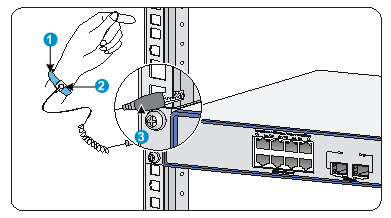
|
(1) ESD-preventive wrist strap |
(2) Lock |
|
(3) Alligator clip |
|
EMI
All electromagnetic interference (EMI) sources, from outside or inside of the wireless switch and application system, adversely affect the wireless switch in a conduction pattern of capacitance coupling, inductance coupling, electromagnetic wave radiation, or common impedance (including grounding system) coupling. To prevent EMI, perform the following steps:
· Take measures against interference from the power grid.
· Do not use the wireless switch together with the grounding equipment or light-prevention equipment of power equipment, and keep the wireless switch far away from them.
· Keep the wireless switch far away from high-power radio launchers, radars, and equipment with high frequency or high current.
|
|
NOTE: Use electromagnetic shielding when necessary. |
Lightning protection
To protect the wireless switch from lightning better, do as follows:
· Make sure the grounding cable of the chassis is well grounded.
· Make sure the grounding terminal of the AC power receptacle is well grounded.
· Install a lightning protector at the input end of the power supply to enhance the lightning protection capability of the power supply.
Installation tools
|
|
|
|
|
|
RJ-45 crimping pliers |
Phillips screwdriver |
Needle-nose pliers |
Wire-stripping pliers |
|
|
|
|
|
|
Diagonal pliers |
ESD-preventive wrist strap |
Multimeter |
Knife |
|
|
NOTE: No installation tool is provided with the wireless switch. Prepare them yourself. |
Accessories
|
|
|
|
|
|
Grounding cable |
M6 screw (user supplied) |
Cage nut (user supplied) |
M4 screw |
|
|
|
|
|
|
Front mounting bracket |
Rubber feet |
Bail latch |
Console cable |
Checklist before installation
Table 6 Checklist before installation
|
Item |
Requirements |
Result |
|
|
Installation site |
Ventilation |
· There is a minimum clearance of 10 cm (3.9 in) around the inlet and exhaust vents for heat dissipation of the wireless switch chassis. · A ventilation system is available at the installation site. |
|
|
Temperature |
0°C to 45°C (32°F to 113°F) |
|
|
|
Relative humidity |
5% to 95% (noncondensing) |
|
|
|
Cleanness |
· Dust concentration ≤ 3 × 104 particles/m3 · No dust on desk within three days |
|
|
|
ESD prevention |
· The equipment and rack are well grounded. · The equipment room is dust-proof. · The humidity and temperature are at a proper level. · Wear an ESD-preventive wrist strap and make sure the wrist strap makes good skin contact and is well grounded when installing FRUs. · Place the removed interface card on an antistatic workbench, with the face upward, or put it into an antistatic bag. · Touch only the edges, instead of electronic components when observing or moving a removed interface card. |
|
|
|
EMI prevention |
· Take effective measures to protect the power system from the power grid system. · Separate the protection ground of the wireless switch from the grounding device or lightning protection grounding device as far as possible. · Keep the wireless switch far away from radio stations, radar and high-frequency devices working in high current. · Use electromagnetic shielding when necessary. |
|
|
|
Lightning protection |
· The grounding cable of the chassis is well grounded. · The grounding terminal of the AC power receptacle is well grounded. · A port lightning arrester is installed. (Optional) |
|
|
|
Electricity safety |
· Equip a UPS. · In case of emergency during operation, switch off the external power switch. |
|
|
|
Rack-mounting requirements |
· Install the wireless switch in an open rack if possible. If you install the wireless switch in a closed cabinet, make sure that the cabinet is equipped with a good ventilation system. · The rack is sturdy enough to support the weight of the wireless switch and installation accessories. · The size of the rack is appropriate for the wireless switch. · The front and rear of the rack are at least 0.8 m (31.50 in) away from walls or other devices. |
|
|
|
Safety precautions |
· The wireless switch is far away from any moist area and heat source. · The emergency power switch in the equipment room is located. |
|
|
|
Tools |
· Installation accessories supplied with the wireless switch · User supplied tools |
|
|
|
Reference |
· Documents shipped with the wireless switch · Online documents |
|
|
Installing the wireless switch
|
|
WARNING! Keep the tamper-proof seal on a mounting screw on the chassis cover intact, and if you want to open the chassis, contact the local agent of H3C for permission. Otherwise, H3C shall not be liable for any consequence caused thereby. |
Figure 5 Wireless switch installation flow
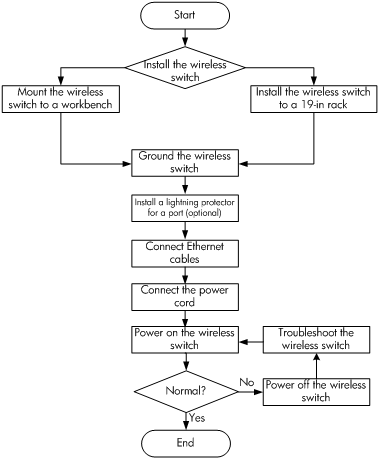
Mounting the wireless switch on a workbench
If a standard 19-inch rack is not available, you can place a WX3010E wireless switch on a clean, flat workbench, as follows:
1. Check that the workbench is sturdy and well grounded.
2. Attach the four rubber feet to the recessed areas on the chassis bottom.
3. Place the wireless switch with upside up on the workbench.
|
|
IMPORTANT: · Ensure good ventilation and 10 cm (3.9 in) of clearance around the chassis for heat dissipation. · Avoid placing heavy objects on the wireless switch. · Keep at least a vertical distance of 1.5 cm (0.59 in) between wireless switches when they are placed one above the other. |
Figure 6 Mounting the wireless switch on a workbench

Installing the wireless switch in a 19-inch rack
|
|
CAUTION: · Ensure a clearance of 1U (44.45 mm, or 1.75 in) between equipment for heat dissipation. · Wear an ESD-preventive wrist strap and make sure the wrist strap makes good skin contact and is well grounded before you install the wireless switch to the rack. |
To install the wireless switch to the 19-inch rack:
1. Unpack the wireless switch and accessories.
2. Mark the positions of cage nuts one by one on the front rack posts by using a front mounting bracket and mark the positions of cage nuts one by one on the rear rack posts by using a rear mounting bracket.
Figure 7 Installing cage nuts

3. Attach the mounting brackets to both sides of the wireless switch with M4 screws.
Figure 8 Attaching mounting brackets to the wireless switch

4. Supporting the bottom of the wireless switch with one hand, horizontally push the wireless switch into the rack until the brackets meet the posts on both sides of the rack.
Figure 9 Installing the wireless switch to the rack
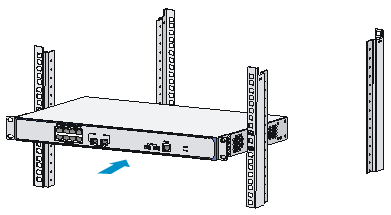
5. Keeping the brackets flush against the posts, align the holes in the brackets with the cage nuts on the rack.
6. Insert and tighten M6 screws to the rack.
Figure 10 Attaching the wireless switch to the rack
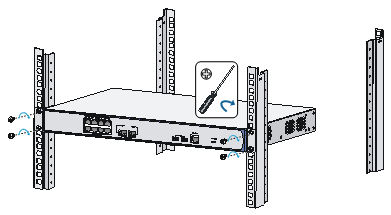
Grounding the wireless switch
|
|
WARNING! · Correctly connecting the wireless switch grounding cable is crucial to lightning protection and EMI protection. · Do not connect the wireless switch grounding cable to a fire main or lightning rod. |
You can ground the wireless switch in one of the following ways, depending on the grounding conditions available at the installation site:
· Grounding the wireless switch with the grounding terminal on the chassis (recommended)
· Grounding the wireless switch with a grounding conductor buried in the earth ground
· Grounding the wireless switch by using the AC power cord
Grounding the wireless switch with the grounding terminal on the chassis (recommended)
To connect the grounding cable:
1. Remove the grounding screw from the rear panel of the wireless switch chassis.
2. Attach the grounding screw to the ring terminal of the grounding cable.
3. Use a Phillips screwdriver to fasten the grounding screw into the grounding screw hole.
4. Connect the other end of the grounding cable to the grounding screw on the rack.
5. Install the grounding screw to the grounding hole on the chassis, and fasten the screw.
Figure 11 Connecting the grounding cable to the grounding hole of wireless switch
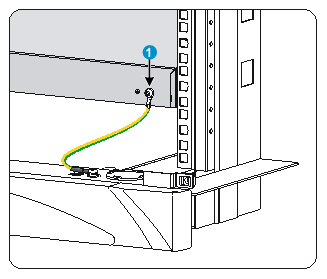
|
(1) Ring terminal |
Grounding the wireless switch with a grounding conductor buried in the earth ground
If earth ground is available at the installation site, hammer a 0.5 m (1.64 ft) or longer angle iron or steel tube into the earth ground to serve as a grounding conductor. Weld the yellow-green grounding cable to the angel iron or steel tube and treat the joint for corrosion protection.
Figure 12 Grounding the wireless switch by burying the grounding conductor into the earth ground
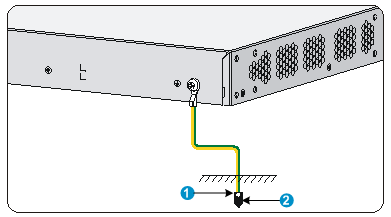
|
(1) Joint |
(2) Grounding conductor |
Grounding the wireless switch by using the AC power cord
If the wireless switch is AC powered, you ground an AC-powered wireless switch through the protective earth (PE) wire of the power cord, and check that the ground contact in the power outlet is well connected to the ground in the power distribution room or on the AC transformer side.
Figure 13 Grounding the wireless switch through the PE wire of the AC power cord
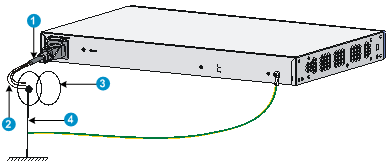
|
(1) Three-wire AC power cord |
(2) PE wire |
|
(3) AC transformer |
(4) Grounding |
Installing a lightning protector for a network port (optional)
|
|
NOTE: · H3C recommends that you install lightning protector for 10/100/1000 Mbps RJ-45 copper Ethernet ports. · Read the instructions for the lightning protector carefully before you install it. · The wireless switch does not come with any lightning protector. |
If part of the network cable of a 10/100/1000 Mbps RJ-45 copper Ethernet port must be routed outdoors, connect a lightning protector to the cable before you plug the cable into the port.
Installation procedures
To install a port lightning protector:
1. Use a double-faced adhesive tape to stick the lightning protector onto the wireless switch chassis, and make sure it is as close to the grounding screw of the wireless switch as possible.
2. Measure the distance between the protector and the grounding screw of the wireless switch, cut the ground wire of the protector as appropriate, and securely tighten the ground wire to the grounding screw of the wireless switch.
3. Use the multimeter to measure whether the ground wire of the protector contacts well with the grounding screw of the chassis.
4. Insert the outdoor network cable into the protector's Surge end, and the cable connected to the wireless switch into the Protect end, and look at the indicators on the lightning protector to verify that the connection is correct.
5. Use nylon ties to bundle the cables neatly.
Figure 14 Installing a lightning protector for a network port

|
(2) Lightning protector |
Precautions
The performance of the port lightning protector may be adversely affected in the following cases:
· The port lightning protector is installed in reverse direction.
You should connect the Surge end to the outdoor network cable and the Protect end to the network port on the wireless switch.
· The port lightning protector is not well grounded.
After the connection, you should use the multimeter to confirm that the ground wire for the protector is as short as possible to ensure its good contact with the grounding screw of the wireless switch.
· The installed port lighting protectors are not sufficient.
If the wireless switch has more than one network port connected with other devices through cables outdoor, you should install a lightning protector for each network port.
Connecting Ethernet cables
Connecting a copper Ethernet port
To connect a copper Ethernet port:
1. Connect one end of the Ethernet cable to the copper Ethernet port of the wireless switch, and the other end to the Ethernet port of the peer device.
2. Check whether the LEDs of the Ethernet port are normal.
|
LED |
Status |
Description |
|
10/100/1000 Base-T autosensing Ethernet port LED (yellow/green) |
Steady green |
The port is operating at 1000 Mbps. |
|
Flashing green |
The port is sending or receiving data at 1000 Mbps. |
|
|
Steady yellow |
The port is operating at 10/100 Mbps. |
|
|
Flashing yellow |
The port is sending or receiving data at 10/100 Mbps. |
|
|
Off |
No link is present. |
Connecting a fiber port
GE SFP transceiver module
The WX3010E wireless switch supports only GE SFP transceiver modules.
|
|
NOTE: No transceiver module is shipped with the wireless switch. H3C transceiver modules are recommended. |
Figure 15 Transceiver module appearance
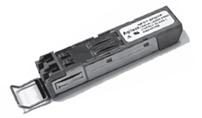
Table 8 Fiber port LED description
|
Item |
SFP-GE-SX-MM850-A |
SFP-GE-LX-SM1310-A |
|
Central wavelength |
850 nm |
1310 nm |
|
Transmission distance |
550 m (1804.46 ft) |
10 km (6.21 miles) |
|
Transmission rate |
1250 Mbps |
1250 Mbps |
|
Connector type |
Duplex LC |
Duplex LC |
|
Fiber mode |
MMF |
SMF |
|
Fiber diameter |
50/125 μm |
9/125 μm |
|
Transmit power |
–9.5 to 0 dBm |
–9.5 to –3 dBm |
|
Receive sensitivity |
≤ –17 dBm |
≤ –20 dBm |
|
Saturation |
≤ –3 dBm |
≤ –3 dBm |
Installing a transceiver module
|
|
WARNING! When connecting an optical fiber, follow these guidelines: · Never bend or curve a fiber when connecting it. After a fiber is installed well, the bend radius must be not less than 10 cm (3.94 in). · Keep the fiber end clean. · Make sure that the fiber connector matches the transceiver module. · Before connecting a fiber, make sure that the optical power at the receiving end does not exceed the upper threshold of the optical receive power of the transceiver module. Otherwise, the transceiver module may be damaged. |
To connect the wireless switch to the network through an optical fiber:
1. Remove the dust plug on the fiber port.
2. Insert the transceiver module into the fiber port.
3. Remove the dust cover of the optical fiber connector, and use dust free paper and absolute alcohol clean the end face of the fiber connector.
4. Plug one end of the optical fiber into the transceiver module in the wireless switch, and plug the other end into the transceiver module in the peer device.
Figure 16 Connecting an optical fiber
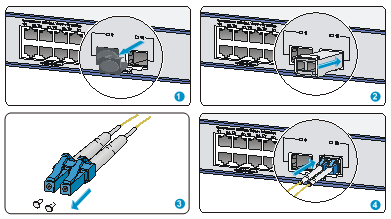
After powering on the wireless switch, check the SFP port status LED.
Table 9 Fiber port LED description
|
LED |
Status |
Description |
|
1000Base-X SFP port LED (green) |
Steady green |
The port is operating at 1000 Mbps. |
|
Flashing green |
The port is sending or receiving data at 1000 Mbps. |
|
|
Off |
No link is present. |
Connecting the AC power cord
|
|
CAUTION: · Use a bail latch to secure the power cord to the wireless switch after connecting the AC power cord. · Before powering on the wireless switch, connect the grounding cable of the wireless switch. · Turn off the power source before connecting the power cord. |
To connect the AC power cord:
1. Make sure the grounding cable is well grounded.
2. Attach the hooks of the bail latch into the holes on the two sides of the AC-input power receptacle, and pull the bail latch upwards.
3. Connect one end of the AC power cord to the AC-input power receptacle on the wireless switch.
4. Pull the bail latch down to secure the plug to the power receptacle.
5. Connect the other end of the power cord to the AC power outlet.
Figure 17 Connecting an AC power cord
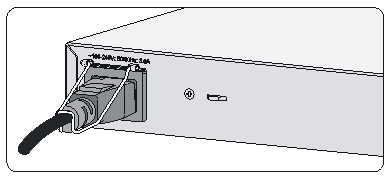
6. Check the PWR LED.
Table 10 PWR LED status
|
LED |
Mark |
Status |
Description |
|
System status LED (green/red) |
PWR |
Steady green |
The wireless switch is performing POST or downloading software. |
|
Flashing green |
The wireless switch is operating properly. |
||
|
Steady red |
POST has failed or other serious faults are detected. |
||
|
Off |
No power is input. |
Verifying the installation
After installation, check that:
· All screws are fastened.
· The grounding cable and power cord are securely connected.
· The correct power source is used.
· All the interface cables are cabled indoors. If any cable is routed outdoors, verify that the socket strip with a lightning protector for network ports has been properly connected.
Logging in to the wireless switch
Login methods
· Logging in through the console port
· Logging in through Telnet
· Logging in through the web interface
Logging in through the console port
To log in through the console port, prepare an 8-core shielded console cable (with a crimped RJ-45 connector at one end and a DB-9 female connector at the other end) and a console terminal (such as a laptop or a PC).
Setting up the configuration environment
|
|
NOTE: · When you connect a PC to a powered-on wireless switch, connect the DB-9 connector of the console cable to the PC before connecting the RJ-45 connector to the wireless switch. · When you disconnect a PC from a powered-on wireless switch, disconnect the DB-9 connector of the console cable from the PC after disconnecting the RJ-45 connector from the wireless switch. |
To set up the configuration environment, plug the DB-9 female connector to the serial port of the console terminal or PC, and connect the RJ-45 connector to the console port of the wireless switch.
Figure 18 Connecting the console cable
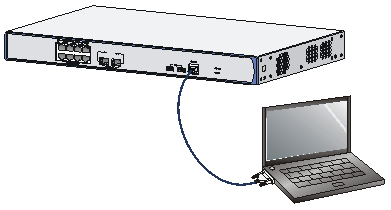
Setting terminal parameters
To set terminal parameters, for example, on a Windows XP HyperTerminal:
1. Select Start > All Programs > Accessories > Communications > HyperTerminal.
The Connection Description dialog box appears.
2. Enter a name for the new connection in the Name field and click OK.
Figure 19 Connection description
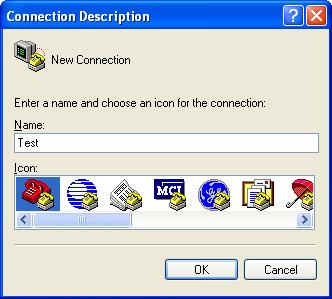
3. Select the serial port to be used from the Connect using list, and click OK.
Figure 20 Setting the serial port used by the HyperTerminal connection
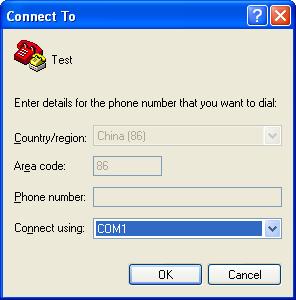
4. Set Bits per second to 9600, Data bits to 8, Parity to None, Stop bits to 1, and Flow control to None, and click OK.
Figure 21 Setting the serial port parameters
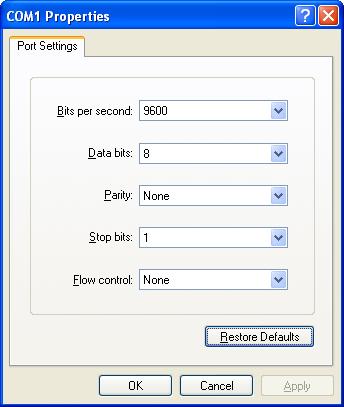
|
|
NOTE: To restore the default settings, click Restore Defaults. |
Figure 22 HyperTerminal window
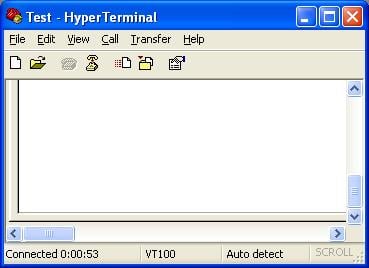
Powering on the wireless switch
Checking before power-on
Before powering on the wireless switch, verify the following items:
· The power cord and grounding cable are properly connected.
· The input power voltage is as required.
· The console cable is properly connected, the terminal or PC used for configuration has started, and the configuration parameters have been correctly set.
Powering on the wireless switch
Switch on the power source of the wireless switch.
Checking after power-on
After powering on the wireless switch, check the following items:
· The LEDs on the front panel are normal.
Table 11 LED status
|
LED |
Mark |
Status |
Description |
|
System status LED |
PWR |
Flashing green |
The wireless switch is operating properly. |
|
PoE/PoE+ status LED |
PoE |
Steady green |
PoE/PoE+ power supply is operating properly. |
· The fans work properly, and you can hear fan rotating.
· The configuration terminal displays information normally. You can see the startup window on the local configuration terminal.
· After the POST, the system prompts you to press Enter. When the command line prompt appears, the wireless switch is ready to configure.
Displaying boot information
Power on the wireless switch, and you can see the following information:
System is starting...
Booting Normal Extend BootWare.
The Extend BootWare is self-decompressing....................Done!
******************************************************
* *
* H3C WX3010E BootWare, Version 0.07 *
* *
******************************************************
Copyright (c) 2004-2011 Hangzhou H3C Technologies Co., Ltd.
Compiled Date : Dec 26 2011
CPU Type : XLS208
CPU L1 Cache : 32KB
CPU Clock Speed : 750MHz
Memory Type : DDR2 SDRAM
Memory Size : 512MB
Memory Speed : 533MHz
BootWare Size : 512KB
Flash Size : 16MB
cfa0 Size : 999MB
CPLD Version : 001
PCB Version : Ver.A
BootWare Validating...
Press Ctrl+B to enter extended boot menu...
Press Ctrl + B at the prompt within four seconds to access the Boot menu. Otherwise, the system enters the system image file reading and self-compressing process.
|
|
NOTE: · To access the Boot menu, you must press Ctrl + B within four seconds at the prompt “Press Ctrl+B to enter extended boot menu”. Otherwise, the system enters the system image file reading and self-compressing process. · To access the Boot menu after the system enters the system image file reading and self-compressing process, restart the wireless switch. |
Starting to get the main application file--cfa0:/wx3000.bin!................
The main application file is self-decompressing.............................
......................................................
......................................................
......................................................
.............................................Done!
System application is starting...
Startup configuration file does not exist.
User interface con0 is available.
Press ENTER to get started.
Logging in through Telnet
You can use the following default settings to log in to the web interface through HTTP:
· Username—admin
· Password—admin
· IP address of VLAN-interface 1 on the wireless switch—192.168.0.100/24.
If you do not want to use the default login information, you can also log in to the wireless switch by following these steps:
1. Log in to the wireless switch through the console port, enable the Telnet function, and set user privileges.
2. Specify an IP address for VLAN-interface 1 of the wireless switch.
3. Connect the PC to the Ethernet port (by default, the Ethernet port belongs to VLAN 1) on the wireless switch.
Logging in through the web interface
You can use the following default settings to log in to the web interface through HTTP:
· Username—admin
· Password—admin
· IP address of VLAN-interface 1 on the wireless switch—192.168.0.100/24.
If you do not want to use the default login information, you can also log in to the wireless switch by following these steps:
1. Log in to the wireless switch through the console port, enable the web function, and set user privileges.
2. Specify an IP address for VLAN-interface 1 of the wireless switch.
3. Connect the PC to the Ethernet port (by default, the Ethernet port belongs to VLAN 1) on the wireless switch.
|
|
NOTE: The CLI and outputs depend on the wireless switch model. |
Logging in to the switching engine by using OAP
You can log in to the operating system of the switching engine from the access controller engine side, and then the command line interface is switched from the access controller engine to the switching engine, where you can manage the system and application software of the switching engine. To return to the command line interface of the access controller engine, press Ctrl+K.
To log in to the switching engine by using OAP at the access controller engine side:
|
Task |
Command |
Remarks |
|
Log in to the switching engine by using OAP at the access controller engine side |
oap connect slot slot-number |
Required Available in user view |
Displaying hardware information about the wireless switch
Displaying software and hardware version information about the access controller engine
Use the display version command to display software and hardware version information of the wireless switch. The output includes the following information: the current software version and hardware version and the wireless switch operating time (the output depends on the software and hardware version of the wireless switch).
· On the access controller engine
<H3C>display version
H3C Comware Platform Software
Comware Software, Version 5.20, Alpha 3501
Copyright (c) 2004-2012 Hangzhou H3C Tech. Co., Ltd. All rights reserved.
H3C WX3010E uptime is 0 week, 0 day, 0 hour, 29 minutes
H3C WX3010E with 1 RMI XLS 208 750MHz Processor
512M bytes DDR2
16M bytes Flash Memory
Config Register points to FLASH
999M bytes CFCard Memory
Hardware Version is Ver.A
CPLD Version is 001
Basic Bootrom Version is 0.07
Extend Bootrom Version is 0.07
[Slot 0]WX3010ELSW Hardware Version is NA
[Slot 1]WX3010ERPU Hardware Version is Ver.A
· On the switching engine
<H3C>display version
H3C Comware Platform Software
Comware Software, Version 5.20, Release 3308P02
Copyright (c) 2004-2012 Hangzhou H3C Tech. Co., Ltd. All rights reserved.
H3C WX3010E-LSW uptime is 0 week, 0 day, 0 hour, 29 minutes
H3C WX3010E-LSW
128M bytes DRAM
16M bytes Nor Flash Memory
Config Register points to Nor Flash
Hardware Version is VER.A
CPLD Version is 001
Bootrom Version is 0.07
[SubSlot 0] 8GE+2SFP+POE Hardware Version is VER.A
Displaying operational statistics for the wireless switch
When you perform routine maintenance or the system fails, you may need to display the operational information of each feature module for locating failures. Generally, you need to run the display commands one by one. To collect more information one time, you can execute the display diagnostic-information command in any view to display or save the operational statistics of multiple feature modules of the wireless switch. This command displays the output of the display clock, display version, display device, and display current-configuration commands.
· Save the operational statistics for each feature module of the wireless switch.
<H3C>display diagnostic-information
Save or display diagnostic information (Y=save, N=display)? [Y/N]:y
Please input the file name(*.diag)[cfa0:/default.diag]:
The file already exists, overwrite it? [Y/N]:y
Diagnostic information is outputting to cfa0:/default.diag.
Please wait...
Save successfully.
Execute the more default.diag command in user view, and then press the Page Up and Page Down keys to view the contents of the file default.diag.
· Display the operational statistics for each feature module of the wireless switch. The output is omitted here.
<H3C>display diagnostic-information
Save or display diagnostic information (Y=save, N=display)? [Y/N]:n
======================================================
==========running CPU usage information============
======================================================
===== Current CPU usage info =====
CPU Usage Stat. Cycle: 57 (Second)
CPU Usage : 2%
CPU Usage Stat. Time : 2012-02-07 02:07:22
CPU Usage Stat. Tick : 0x22(CPU Tick High) 0xbd4f4ef8(CPU Tick Low)
Actual Stat. Cycle : 0x0(CPU Tick High) 0xe4146bcb(CPU Tick Low)
Displaying detailed information about the wireless switch
Use the display device verbose command to display detailed information about the wireless switch.
· On the access controller engine
<H3C>display device verbose
Slot No Board Type Status Max Ports
0 WX3010ELSW Normal -
1 WX3010ERPU Normal 2
Table 12 Command output (on the access controller engine)
|
Field |
Description |
|
Slot No. |
Slot number of the access controller engine |
|
Board Type |
Access controller engine model |
|
Status |
Operational status of the access controller engine: · Fault—The access controller engine in the slot has failed and cannot boot properly. · Normal—The access controller engine in the slot is operating properly. |
|
Max Ports |
Maximum number of interfaces that the access controller engine supports |
· On the switching engine
<H3C>display device verbose
Slot 1
SubSNo PortNum PCBVer FPGAVer CPLDVer BootRomVer AddrLM Type State
0 12 Ver.A NULL 001 0.07 IVL MAIN Normal
Slot 1 Subslot 0 info:
Status : Normal
Type : MAIN
Software Ver : Release 3308P02
PCB Ver : Ver.A
FPGA Ver : NULL
BootRom Ver : 0.07
CPLD Ver : 001
PortNum : 12
Chip : 0
Learning Mode: IVL
Table 13 Command output (on the switching engine)
|
Field |
Description |
|
SubSNo |
Slot number of the switching engine |
|
PortNum |
Maximum number of interfaces that the switching engine supports |
|
PCBVer |
PCB version of the switching engine |
|
FPGAVer |
FPGA version of the switching engine |
|
CPLDVer |
CPLD version of the switching engine |
|
BootRomVer |
Boot ROM version of the switching engine |
|
AddrLM |
Address learning mode |
|
Type |
Switching engine model |
|
State |
Switching engine status |
Displaying the electronic label data for the wireless switch
Use the display device manuinfo command to display the electronic label data for the wireless switch.
An electronic label is a profile of a wireless switch and contains the permanent configuration including the serial number, manufacturing date, MAC address, and vendor name.
· On the access controller engine
<H3C>display device manuinfo
Slot 1:
Subslot 0
DEVICE_NAME : WX3010E-PoEP
DEVICE_SERIAL_NUMBER : DPPMWWB123456
MAC_ADDRESS : 000f-e212-6103
MANUFACTURING_DATE : 2006-08-08
VENDOR_NAME : H3C
· On the switching engine
<H3C>display device manuinfo
Slot 1:
DEVICE_NAME : WX3010E-PoEP
DEVICE_SERIAL_NUMBER : DPPMWWB123456
MAC_ADDRESS : 0021-632F-E18B
MANUFACTURING_DATE : 2008-10-30
VENDOR_NAME : H3C
Table 14 Command output
|
Field |
Description |
|
DEVICE_NAME |
Wireless switch model |
|
DEVICE_SERIAL_NUMBER |
Serial number of the wireless switch |
|
MAC_ADDRESS |
MAC address of the wireless switch |
|
MANUFACTURING_DATE |
Manufacturing data of the wireless switch |
|
VENDOR_NAME |
Vendor name |
Displaying the CPU usage of the wireless switch
Use the display cpu-usage command to display the CPU usage statistics for the wireless switch.
<H3C>display cpu-usage
Unit CPU usage:
1% in last 5 seconds
1% in last 1 minute
1% in last 5 minutes
Table 15 Command output
|
Field |
Description |
|
Unit CPU usage |
CPU usage |
|
1% in last 5 seconds |
Average CPU usage in the last five seconds (after the wireless switch boots, the wireless switch calculates and records the average CPU usage at the interval of five seconds). |
|
1% in last 1 minute |
Average CPU usage in the last minute (after the wireless switch boots, the wireless switch calculates and records the average CPU usage at the interval of one minute). |
|
1% in last 5 minutes |
Average CPU usage in the last five minutes (after the wireless switch boots, the wireless switch calculates and records the average CPU usage at the interval of five minutes). |
Displaying the memory usage of the wireless switch
Use the display memory command to display the memory usage statistics for the wireless switch.
<H3C>display memory
System Total Memory(bytes): 214811120
Total Used Memory(bytes): 54536080
Used Rate: 25%
|
Field |
Description |
|
System Total Memory(bytes) |
Physical memory size (in bytes) of the wireless switch |
|
Total Used Memory(bytes) |
Used memory size (in bytes) of the wireless switch |
|
Used Rate |
Memory usage of the wireless switch |
Displaying the operational status of the built-in fans
Use the display fan command to display the operating states of fans.
<H3C>display fan
Fan 1 State: Normal
Fan 2 State: Normal
Fan 3 State: Normal
Table 17 Command output
|
Field |
Description |
|
Fan 1 |
Number of the fan |
|
State |
Fan state: · Normal—The fan is operating properly. · Absent—The fan is not in position. · Fault—The fan has failed. |
Displaying the operating state of a power module
Use the display power command to display the operating state of a power module.
<H3C>display power
Power 1 State: Normal
Table 18 Command output
|
Field |
Description |
|
Power 1 |
Number of the power module |
|
State |
Power module state: · Normal—The power module is operating properly. · Absent—The power module is not in position. · Fault—The power module has failed. |
Configuring the exception handling method
Configuration procedure
You can configure the wireless switch to handle system exceptions (such as system instruction faults, invalid addresses, data overflow, null pointers, and division by zero operations) in one of the following methods:
· reboot—The wireless switch automatically reboots to recover from the error condition.
· maintain—The wireless switch stays in the error condition so you can collect complete data, including error messages, for diagnosis. In this approach, you must manually reboot the wireless switch.
To configure the exception handling method:
|
Step |
Command |
Remarks |
|
1. Enter system view. |
system-view |
N/A |
|
2. Specify the exception handling method. |
system-failure { maintain | reboot } |
Optional. By default, the wireless switch reboots when an exception occurs. |
Displaying the exception handling method
Use the display system-failure command to display the exception handling method.
<H3C> display system-failure
System failure handling method: reboot
Rebooting the wireless switch
When upgrading and maintaining the system software image file, or configuration file for the wireless switch, you must reboot the wireless switch. To reboot a wireless switch, use one of the following methods:
· Reboot the wireless switch immediately at the CLI.
· At the CLI, schedule a reboot to occur at a specific time and date or after a delay.
· Power off and then re-power on the wireless switch. This method might cause data loss, and is the least preferred method.
Reboot at the CLI enables easy remote device maintenance.
To reboot the wireless switch immediately:
|
Task |
Command |
Remarks |
|
Reboot the wireless switch immediately. |
reboot |
Required Available in user view |
To schedule a reboot for the wireless switch:
|
Task |
Command |
Remarks |
|
Schedule a reboot. |
·
Schedule a reboot to occur at a specific time
and date: ·
Schedule a reboot to occur after a delay: |
Use either command. The scheduled reboot function is disabled by default. Available in user view. |
|
|
CAUTION: · If the main system software image file has been corrupted or does not exist, the device cannot reboot. You must re-specify a main system software image file, or power off the device and then power it on so the system can reboot with the backup system software image file. · The alert "REBOOT IN ONE MINUTE" appears one minute before the reboot time. · For data security, if you are performing file operations at the reboot time, the system does not reboot. |
Power supply failure
If the wireless switch cannot be powered on and the system status LED PWR is off, verify the following items:
· The external AC power system is correctly working.
· The AC power cord is securely connected to the wireless switch.
· The power cord is in good condition.
|
|
NOTE: If the problem persists, contact the H3C technical support for help. |
Configuration terminal problems
If the configuration environment setup is correct, the configuration terminal displays booting information when the wireless switch is powered on. If the setup is incorrect, the configuration terminal displays nothing or garbled text.
No terminal display
If the configuration terminal displays nothing when the switch is powered on, verify the following items:
· The power supply is supplying power to the wireless switch.
· The console cable is properly connected.
· The console cable has no problem and the terminal settings are correct.
Garbled terminal display
If terminal display is garbled, verify that the following settings are configured for the terminal, for example, HyperTerminal:
· Baud rate—9,600
· Data bits—8
· Parity—none
· Stop bits—1
· Flow control—none
· Emulation—VT100
Login password loss
If you forget the login password, you can set a new password by following these steps:
1. Select 6 from the BootWare menu to start the system without loading the system configuration.
The following information appears:
Flag Set Success.
2. When the BootWare menu appears again, select 0 to restart the system.
System is rebooting now.
System start booting...
Booting Normal Extend BootWare....
3. Restart the wireless switch and set a new password.
<H3C>system-view
[H3C]user-interface console 0
[H3C-ui-console0]authentication-mode password
[H3C-ui-console0]set authentication password simple 123456
When you set the password by using the set authentication password { cipher | simple } password command, follow these guidelines.
· If the cipher keyword is specified, the password is stored in cipher text. You cannot see the password by using the display current-configuration command.
· If the simple keyword is specified, the password is stored in plain text. You can use the display current-configuration command to view the password in the current configuration.
|
|
NOTE: After reboot, the system runs with the initial default configuration, but the original configuration file is still stored in the storage medium. To restore the original configuration, use the display saved-configuration command to display the configuration, and then copy and execute the configuration. |
4. Save the new configuration.
<H3C> save
|
|
NOTE: · After you modify the login password, use the save command to save it. · Save the configuration to the default configuration file. |
Software loading failure
If software loading fails, the system runs the software of the previous version. To troubleshoot the software loading failure:
· Check whether the physical ports are correctly connected. If the cable of any port is not connected, re-connect the cable to the port, and make sure that the physical connection is correct. Then, perform software loading again.
· Check for errors in the software loading process displayed on the HyperTerminal. If errors exist, correct them, and perform software loading again.
For example, the software loading failures may occur in the following cases:
· When you use XMODEM to load software, you select a baud rate other than 9600 bps, but you have not re-set the baud rate for the HyperTerminal.
· When you use TFTP to load software, you have input an incorrect IP address, software name, or TFTP serve path.
· When you use FTP to load software, you have input an incorrect IP address, software name, username, or password.
If software loading has failed even if the physical connections are in good condition and the software loading process does not have any input errors, contact the local sales agent.












